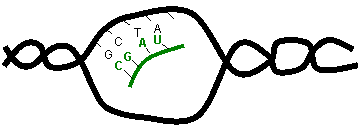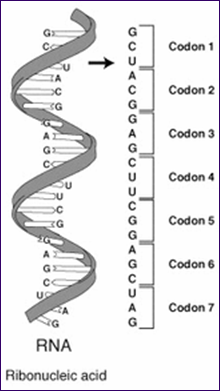From DNA to protein: transcription and translation

Proteins - large, complex molecules built from amino acids - perform most life functions. How is a DNA sequence converted to a protein?
Two main steps: transcription and translation
In transcription, the DNA sequence is copied on to molecules of messenger RNA (mRNA).
 This process is similar to DNA replication in that the double helix opens up so that one strand can be used as a template for the new strand, in this case, of RNA (shown in green).
This process is similar to DNA replication in that the double helix opens up so that one strand can be used as a template for the new strand, in this case, of RNA (shown in green).
RNA is very similar to DNA except that in RNA, thymine (T) is replaced by uracil (U). This means that wherever there was an A in the DNA, the RNA will carry a U.
 In translation the information now encoded on the RNA is deciphered (translated) into a protein.
In translation the information now encoded on the RNA is deciphered (translated) into a protein.
Sets of three nucleotides (called codons) determine which amino acid will be added next to the growing protein chain. For example, GCU, the first codon in the figure, encodes alanine. The next slide shows all the codons and their corresponding amino acids.





